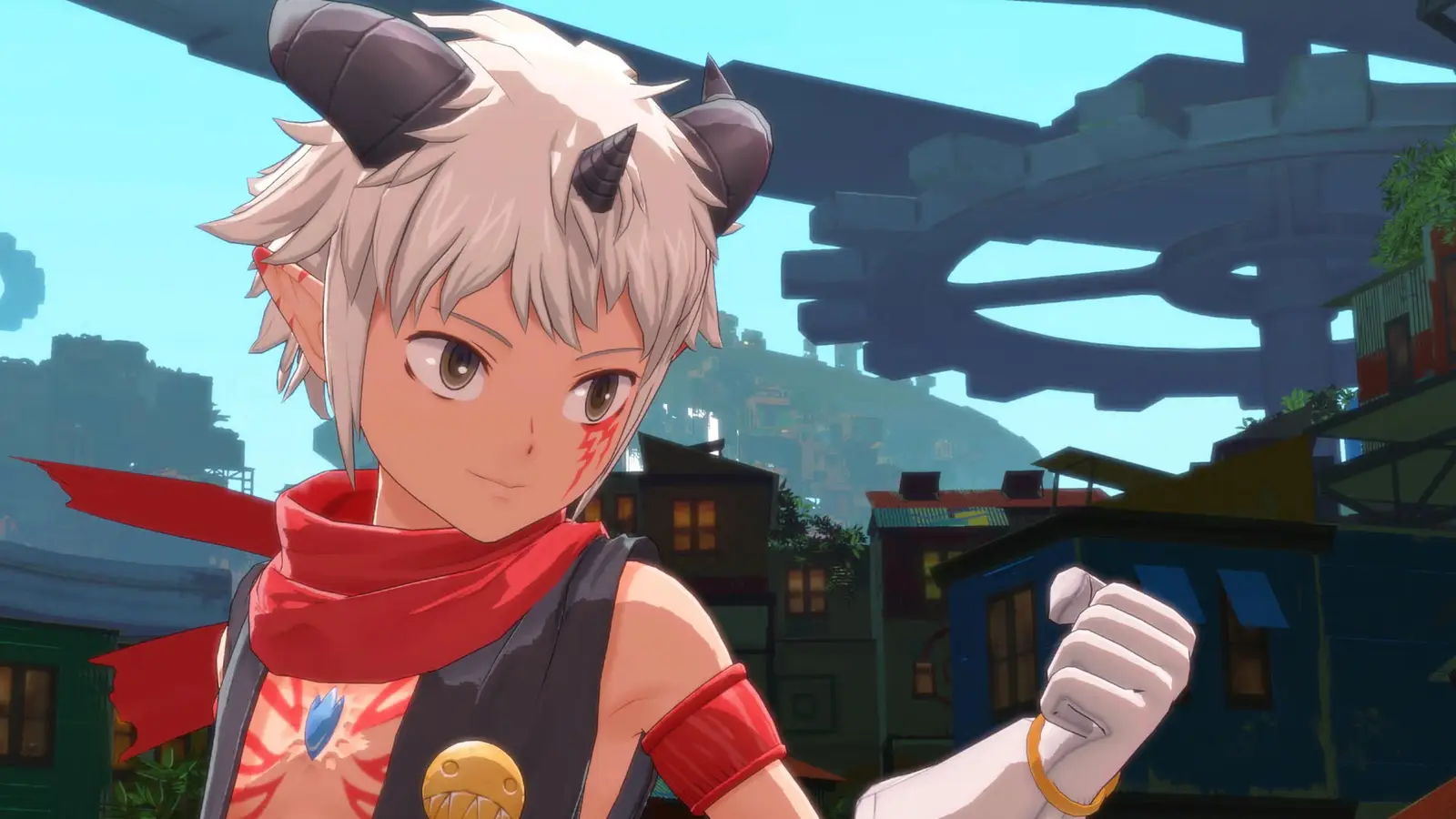
Nothing could prepare me for my first visit to Central Town. After fighting Titamon, I was sucked into a portal and arrived at this place where buildings are brightly colored with hues of red, yellow, and blue. There’s music and the sound of Digimon chatting. I quickly found Zudomon working in front of a large anvil. If I wanted to reach the main tower, I could use Pegasusmon’s services. While spending time in the tavern, I came across a Lillymon serving drinks.
Never has a Digiworld felt so alive in a game as it does in Digimon Story Time Stranger.
After seven years since the release of the last Digimon Story game, developer Media.Vision updates the monster-taming RPG formula it worked on in previous entries to create Digimon Story Time Stranger. Out Oct. 2 for PlayStation 5, Windows PC, and Xbox Series X, Time Stranger has an intricate narrative involving time-traveling and the power behind accepting each other’s differences to work toward a common goal. Digimon Story Time Stranger is the perfect embodiment of all the potential this franchise has.
In Time Stranger, you can choose between the male (Dan Yuki) or female (Kanan Yuki) protagonist, but the story is the same either way. You are an agent of the special investigation bureau ADAMAS. After meeting Inori Misono — a girl who, for some reason, knows the protagonist — you travel to a time before Tokyo becomes the stage of a conflict between Digimon. Once in the past, your agent meets Inori Misono again, but this time the girl is only learning about the “phase electron lifeforms.”
Unlike the ominous future from which your agent came, the existence of Digimon was not common knowledge in the past. But, after venturing into the underground with her friend, the quite reckless Inori has a fortuitous meeting with Elecmon, and after saving this Digimon, it digivolves to Aegiomon. Although this beginning is a slow burn compared to the rest of the game, I couldn’t see it working any other way. Because we know the future, we can’t help but wish to know about the past. As the connection between the group becomes stronger, your agent goes on a journey to protect the Digiworld Iliad from the Titans, a faction that seeks to destabilize the current Digimon society while seeking revenge for a curse put upon them.
The story in Time Stranger is split into three layers that explore ADAMAS, the past of Inori, and the secrets behind Aegiomon. These three fronts are thrown at us at the beginning of the game, which made me feel a bit overwhelmed by the amount of information I was trying to digest in the first hours of gameplay. To enjoy the beginning of Time Stranger you must believe in the process and that everything will eventually make sense. The leap of faith is rewarded as we see characters’ arcs concluding in emotional scenes or when the simple “save the world” theme is questioned as nuance is slowly added to the narrative.
Part of the reason why Digimon Story Time Stranger is memorable lies in how Media.Vision designed the world where this story is told. Although there are segments in which we spend time in the human society and explore the stores and alleys of Shinjuku, most of the time we are visiting places in the Digiworld, which is filled with life. Every region is a vibrant representation of a microcosmos where we can see Digimon performing all kinds of activities. They were not placed by the developer to only make the game look like a Digimon game; each NPC feels like they belong and live in the region we’re visiting.
Since Iliad has never been given form in a Digimon game, discovering new areas and learning about them creates a constant sense of intrigue. Questions like “What does the next area look like?” and “Who are the Digimon living there?” were constantly popping in my head as I progressed in the campaign. In the first half of the game, I visited areas like the Gear Forest, a region where insect, plant, and bird-like Digimon live, and the Abyss Area, a water region where I can call Whamon to take me to the lowest part of the ocean and request Submarimon’s help to swim through strong currents. These places are connected by other Digimon like Locomon and Blipmon (a train and airship monster, respectively) who help the world of Iliad to work as it should.
The care in creating detailed environments and the societies around which the places are built is an extraordinary change brought to Time Stranger. In previous Digimon Story games, most of what we saw was white mysterious buildings and representations of the virtual world that, in general, looked like monotonous blue-colored dungeons. These dull scenarios were a sad representation of a world we know is rich from the anime shows and other games. Time Stranger captures all the fun and beauty of these worlds and Medial.Vision lets us experience them when creating the Digiworld regions.
Exploration is motivated by the other half of any Digimon game’s heart: Capturing creatures. In Digimon Story games, you scan a monster’s data when you defeat them. Once you acquire at least 100% (200% is the maximum!) of its data, you can convert it into a real Digimon and start leveling it up. Since there are multiple types of Digimon living in each environment, exploring every corner is an important part of making the strongest team you possibly can.
The battles are turn-based and structured around a complex rock-paper-scissors system that involves the Digimon type (Vaccine or Virus, for example), damage type (physical or magical), and elements. While this system is already enough to force you to think before acting, new systems have been added to fights against bosses, like a break bar, which you can deplete to stop a strong attack. These additions make a few battles feel as epic as key encounters in the anime.
The downside of more intricate combat is that it makes encounters last longer and feel tiring. Because of that, I was happy to see that Media.Vision, following a trend we have been seeing in games like Trails through Daybreak and Metaphor: ReFantazio, implemented a quick, on-field attack that instantly kills weak enemies. This simple decision makes scanning Digimons and leveling up feel faster.
What hasn’t changed much in Time Stranger is the time you must spend to digivolve your creatures. Seeing a digitama (the egg state of a Digimon) grow into its Mega form is an intrinsically fun element in any Digimon media. In Time Stranger, the next form a Digimon will unlock depends on some prerequisites that range from attributes, personality, or unique items. You may turn Veemon into ExVeemon only if it has a certain amount of Speed, but it becomes Flamedramon if you have the DigiEgg of Courage. Thankfully, you can digivolve your Digimon from the main menu, making it only a matter of spending a couple of minutes to acquire a badass new pal.
Preparing them to digivolve is a completely different story.
Your main tool to train Digimon and make them able to digivolve is the farm. Trust me, you will be visiting it a lot in this game. Since you can only place and remove Digimon from the farm, or start and change their training by talking to Mirei Mikagura, who you can find in the In-Between Theater (a place connected to both worlds), managing evolution always forces a break from whatever you’re doing. It’s difficult to understand why some processes have been streamlined or tweaked in this game, but when it comes to the farm, it’s still understood as a separate (spatially and conceptually) experience from the campaign.
While it has room to improve, Digimon Story Time Stranger is exactly what I wanted from a Digimon game. Media.Visions understands that the fun and excitement that Digimon offers comes from its rich world and curious creatures. By giving life to them with mesmerizing colors, intense combat, and gorgeous animations, the studio evolves what a Digimon game can be and raises the bar of what we will expect from future ones.



